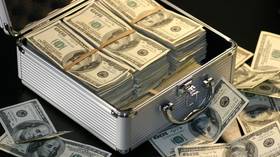World flooded with $100 bills may be sign of international corruption – experts

The number of US one hundred dollar notes has doubled since the financial crisis to more than 12 billion across the world, the latest US Federal Reserve data shows. Experts believe the surge could be linked to global corruption.
C-notes ($100) have passed $1 bills in circulation, Deutsche Bank chief international economist Torsten Slok said in a note to clients, according to CNBC.
Experts say high denomination, high-value currency notes have historically been a preferred form of payment for criminals. They are citing anonymity, the lack of transaction records and the relative ease with which such notes can be brought across borders.
Also on rt.com EU to investigate €500 note link to terrorismThe growth of $100 bills in circulation is a signal the world is relying on them as a store of value while still using them for international crime, said Nicholas Colas, co-founder of DataTrek Research.
“It has nothing to do with the US economy and nothing to do with interest rates,” he said. “There's certainly enough evidence to say it is an enabler of corruption, but it is also a way for people to keep assets outside of the financial system albeit in a kind of bulky way.”
Colas pointed out that the number of hundred dollar bills abroad began surging after the Gulf War and US invasion of Afghanistan. Part of stabilizing the region meant replacing local currencies with something, and “that something was the US dollar."
Also on rt.com Switzerland & United States are the world’s most corrupt nations – reportThe increase in C-notes could be “driven by a global fear of negative interest rates in Europe and Japan, or it could be a savings vehicle for US households worried about another financial crisis, or it could be driven by more demand from the global underground economy,” Deutsche Bank’s Slok said.
The Federal Reserve Bank of Chicago’s 2018 research paper showed that 60 percent of all US bills and almost 80 percent of all $100 bills are now overseas. That's up from 15 to 30 percent around 1980, according to research from Federal Reserve Board economist Ruth Judson. Economic and political instability contribute to that demand, she found.
For more stories on economy & finance visit RT's business section














